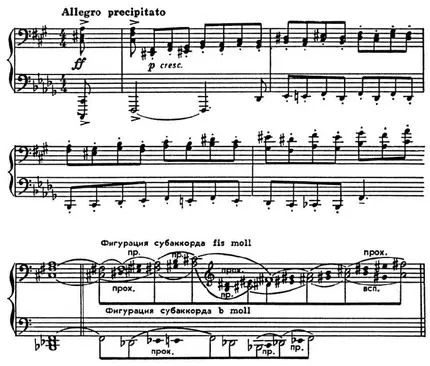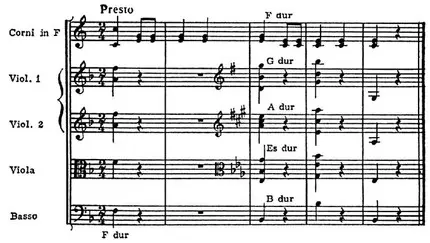
Polytonality |
from the Greek polus – many and tonality
A special type of tonal presentation, a composite (but unified) system of pitch relations, used predominantly. in modern music. P. – “not the sum of several keys … but their complex synthesis, giving a new modal quality – a modal system based on polytonicity” (Yu. I. Paisov). P. can take the form of combining multi-tonal chords (chord P.), multi-tonal melodic. lines (melodic. P.) and combining chords and melodic. lines (mixed P.). Outwardly, P. sometimes looks like a superposition of tonally disparate substructures on top of each other (see the example below).
P., as a rule, has a single center (“politonic”, according to Paisov), which, however, is not monolithic (as in the usual key), but multiple, polyharmonically stratified (see Polyharmony). Parts of it (“subtonic”, according to Paisov) are used as tonics of simple, diatonic keys (in such cases, P. is a “pseudochromatic” whole, according to V. G. Karatygin; see Polyladovost).

S. S. Prokofiev. “Sarcasms”, No 3.
The general basis for the emergence of P. is a complex (dissonant and chromatic) modal structure, in which the tertian structure of chords can be preserved (especially at the level of subchords). The polytonic example from Prokofiev’s “Sarcasms” – the polychord b – des (cis) – f – ges (fis) – a – is a single complex center of the system, and not two simple ones, into which, of course, we decompose it (triads b-moll and fis-moll); therefore, the system as a whole is not reducible either to one ordinary key (b-moll), or to the sum of two (b-moll + fis-moll). (Just as any organic whole is not equal to the sum of its parts, the consonance of multi-tonal substructures is fused into a macrosystem that cannot be reduced to a simultaneous combination of two or several keys: “synthesis during listening”, polytonal voices “are colored into one dominant key” – In V. Asafiev, 1925; accordingly, such a macrosystem should not be called by the name of one old monotonality, much less by the name of two or several old monotonities, for example, it cannot be said that Prokofiev’s play – see the musical example – was written in b-moll.)
Related to the concept of P. are the concepts of polymode, polychord, polyharmony (the difference between them is the same as between the fundamental concepts: tonality, mode, chord, harmony). The main criterion indicating the presence of exactly P. as at the same time. deployment diff. keys, the condition is that each of them be represented not by one consonance (or figuration without harmonic changes), but by a clearly audible functional follow-up (G. Erpf, 1927; Paisov, 1971).
Often the concepts of “poly-mode”, “poly-chord” and “polyharmony” are mistakenly mixed with P. The reason for mixing the concepts of poly-mode or poly-chord with P. usually gives an incorrect theoretical. interpretation of perceptual data: e.g. main the tone of the chord is taken as the main. the tone (tonic) of the key or, for example, the combination of C-dur and Fis-dur as chords (see the theme of Petrushka from the ballet of the same name by I. F. Stravinsky, a musical example on strip 329) is taken as a combination of C-dur and Fis- dur as keys (i.e. chords are erroneously designated by the term “tonality”; this mistake is made, for example, by D. Millau, 1923). Therefore, most of the examples of P. given in the literature do not really represent it. Extraction of harmonics layers from a complex tonal context gives the same (incorrect) results as tearing out the harmonies of individual voices in a fugue from a simple tonal context (for example, bass in the b-moll fugue stretta by Bach, The Well-Tempered Clavier, 2nd volume, bars 33 -37 would be in the Locrian mode).
The prototypes of polystructures (P.) can be seen in some samples of nar. music (eg sutartines). In European polyphony is an early preform of P. – modal two-layered (last Quarter of the 13th – first Quarter of the 15th centuries) with a characteristic “Gothic cadence” of the type:
cis — d gis — a e – d (see Cadence).
Glarean in the Dodecachord (1547) admitted at the same time. combination presented by different voices diff. frets. A well-known example of P. (1544) – “Jewish dance” by X. Neusiedler (in the publication “Denkmäler der Tonkunst in Österreich”, Bd 37) – in reality does not represent P., but polyscale. Historically, the first “polytonally” recorded false polychord is in the concluding. bars of “A Musical Joke” by W. A. Mozart (K..-V. 522, 1787):

Occasionally, phenomena perceived as P. are found in the music of the 19th century. (M. P. Mussorgsky, Pictures at an Exhibition, “Two Jews”; N. A. Rimsky-Korsakov, 16th variation from “Paraphrase” – on a theme proposed by A. P. Borodin). The phenomena referred to as P. are characteristic of the music of the 20th century. (P. Hindemith, B. Bartok, M. Ravel, A. Honegger, D. Milhaud, C. Ive, I. F. Stravinsky, S. S. Prokofiev, D. D. Shostakovich, K. Shimanovsky, B. Lutoslavsky and etc.).
References: Karatygin V. G., Richard Strauss and his “Electra”, “Speech”, 1913, No 49; his own, “The Rite of Spring”, ibid., 1914, No. 46; Milo D., Little explanation, “Toward New Shores”, 1923, No 1; his, Polytonality and atonality, ibid., 1923, No 3; Belyaev V., Mechanics or Logic?, ibid.; his own, Igor Stravinsky’s “Les Noces”, L., 1928 (abbr. Russian variant in ed.: Belyaev V. M., Mussorgsky. Scriabin. Stravinsky, M., 1972); Asafiev B. AT. (Ig. Glebov), On polytonality, Modern Music, 1925, No 7; his, Hindemith and Casella, Modern Music, 1925, No 11; his own, Preface in the book: Casella A., polytonality and atonality, trans. from Italian, L., 1926; Tyulin Yu. N., Teaching about harmony, M.-L., 1937, M., 1966; his own, Thoughts on Modern Harmony, “SM”, 1962, No 10; his, Modern Harmony and Its Historical Origin, in: Questions of Contemporary Music, 1963, in: Theoretical Problems of Music of the 1967th Century, M., 1971; his own, Natural and alteration modes, M., XNUMX; Ogolevets A. S., Fundamentals of the harmonic language, M.-L., 1941, p. 44-58; Skrebkov S., On Modern Harmony, “SM”, 1957, No 6; his own, Answer V. Berkov, ibid., No. 10; Berkov V., More about polytonality. (Concerning the article by S. Skrebkova), ibid., 1957, No. 10; ego, The dispute is not over, ibid., 1958, No 1; Blok V., Several remarks on polytonal harmony, ibid., 1958, No 4; Zolochevsky B. N., About polyladotonality in Ukrainian Soviet music and folk sources, “Folk Art and Ethnography”, 1963. Prince. 3; his own, Modulation and polytonality, in collection: Ukrainian Musical Studies. Vol. 4, Kipv, 1969; his own, About modulation, Kipv, 1972, p. 96-110; Koptev S., On the history of the question of polytonality, in: Theoretical problems of music of the XX century, issue 1, M., 1967; his, On the Phenomena of Polytonality, Polytonality and Polytonality in Folk Art, in Sat: Problems of Lada, M., 1972; Kholopov Yu. N., Modern features of Prokofiev’s harmony, M., 1967; his own, Essays on Modern Harmony, M., 1974; Yusfin A. G., Polytonality in Lithuanian folk music, “Studia musicologica Academiae scientiarum Hungaricae”, 1968, t. ten; Antanavichyus Yu., Analogies of the principles and forms of professional polyphony in sutartin, “Folk Art”, Vilnius, 10, No 1969; Diachkova L. S., Polytonality in Stravinsky’s work, in: Questions of Music Theory, vol. 2, Moscow, 1970; Kiseleva E., Polyharmony and polytonality in the work of C. Prokofiev, in: Questions of Music Theory, vol. 2, M., 1970; Raiso V. Yu., Once again about polytonality, “SM” 1971, No 4; his own, Problems of polytonal harmony, 1974 (diss); his, Polytonality and musical form, in Sat: Music and Modernity, vol. 10, M., 1976; his, Polytonality in the work of Soviet and foreign composers of the XX century, M., 1977; Vyantskus A., Theoretical foundations of polyscale and polytonality, in: Menotyra, vol. 1, Vilnius, 1967; his, Three types of polytonality, “SM”, 1972, No 3; his own, Ladovye formations. Polymodality and polytonality, in: Problems of Musical Science, vol. 2, Moscow, 1973; Khanbekyan A., Folk diatonic and its role in the polytonality of A. Khachaturian, in: Music and Modernity, vol. 8, M., 1974; Deroux J., Polytonal Music, “RM”, 1921; Koechlin M. Ch., Evolution of harmony. Contemporary period…, в кн.: Encyclopedia of music and dictionary of the conservatory, founder A. Lavignac, (v. 6), pt. 2 p., 1925; Erpf H., studies on the harmony and sound technology of modern music, Lpz., 1927; Mersmann H., The Tonal Language of New Music, Mainz, 1928; его же, music theory, В., (1930); Terpander, The Role of Polytonality in modern music, The Musical Times, 1930, Dec; Machabey A., Dissonance, polytonalitй et atonalitй, «RM», 1931, v. 12; Nьll E. v. d., Modern Harmony, Lpz., 1932; Hindemith P., Instruction in composition, (Tl 1), Mainz, 1937; Pruvost Вrudent, De la polytonalitй, «Courier musicale», 1939, No 9; Sikorski K., Harmonie, cz. 3, (Kr., 1949); Wellek A., Atonality and polytonality – an obituary, «Musikleben», 1949, vol. 2, H. 4; Klein R., Zur Definition der Bitonalitдt, «ЦMz», 1951, No 11-12; Boulez P., Stravinsky demeure, в сб.: Musique russe, P., 1953; Searle H., Twentieth century counterpoint, L., 1955; Karthaus W., The System of Music, V., 1962; Ulehla L., Contemporary harmony, N. Y., 1966; Lind B. v.



